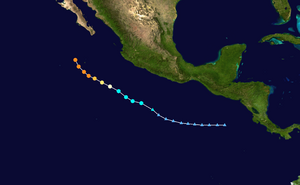Hurricane Hilary (2023) facts for kids
Hurricane Hilary was a powerful storm that started in the Pacific Ocean. It later moved over the southwestern United States. Hilary was the eighth named storm, sixth hurricane, and fourth major hurricane of the 2023 Pacific hurricane season.
The storm began as a weather disturbance south of Mexico around August 12. This disturbance slowly became more organized. On August 16, it officially became Tropical Storm Hilary near Manzanillo, Colima. The very next day, Hilary quickly grew stronger and turned into a hurricane.
As Hilary moved west-northwest on August 17 and 18, it got much stronger very quickly. It reached its peak as a Category 4 hurricane. Its strongest winds were about 145 miles per hour (233 km/h). After reaching its peak, Hilary quickly became weaker. This happened because it moved over cooler ocean water, into drier air, and faced stronger winds high up in the atmosphere.
After weakening into a tropical storm, Hilary made landfall in San Quintín, Baja California, Mexico, on August 20. This was about 215 miles (346 km) south-southeast of San Diego, California.
Hilary was the first tropical storm to directly hit California since the 1939 Long Beach tropical storm. Because of fears of "very dangerous and severe flooding," the National Hurricane Center (NHC) issued a rare tropical storm warning for Southern California. This warning stretched from the Mexico–United States border up to just north of Los Angeles.
Weather experts predicted very heavy rainfall, possibly "more than a year’s worth of rain" in some places. Flood watches were put in place for about 26 million people in four states: Arizona, California, Nevada, and Utah. The entire area was at high risk for flash flooding. Hurricane Hilary caused one death directly and three other deaths related to the storm in Mexico.
Contents
What Happened During Hurricane Hilary?
Impact in Mexico
Heavy rains from the developing storm affected parts of southern and western Mexico. Ports along the Pacific coast from Oaxaca to Colima were closed on August 17. This was to keep ships safe.
Coastal areas of Sinaloa received huge amounts of rain as the hurricane passed. The first death was reported on August 18 in Navolato. Damage was also seen in towns like Angostura, Badiraguato, Elota, and Salvador Alvarado.
On the Baja California peninsula, almost 1,900 people had to leave their homes and go to safe shelters.
Impact in the United States
Many flash flood warnings were issued across Southern California, including Los Angeles. Roads in Death Valley National Park were flooded. Parts of major highways like Interstate 8, Interstate 10, Interstate 15, California State Route 14, and the Pacific Coast Highway had to close. This was due to flooding and falling rocks.
Floodwaters entered Eisenhower Medical Center, but this did not stop the hospital from working. Cars were stuck in water in Palm Springs and Coachella Valley. Palm Springs declared a local state of emergency. Pixar Pier was temporarily cleared out after warning sirens were heard there. A tornado warning was even issued for Alpine and Descanso.
People needed to be rescued from water in the San Diego area. Emergency phone lines (9-1-1) were down in Palm Springs, Cathedral City, and Indio. Indio also declared a local state of emergency.
Because of the storm, at least 1,000 flights were canceled, and 3,700 flights were delayed. More than 5,000 homes and businesses lost electricity, according to the Los Angeles Department of Water and Power.
See also
- Other storms named Hilary
- Tropical cyclones in 2023
- Weather of 2023
- Timeline of the 2023 Pacific hurricane season
- List of Category 4 Pacific hurricanes


